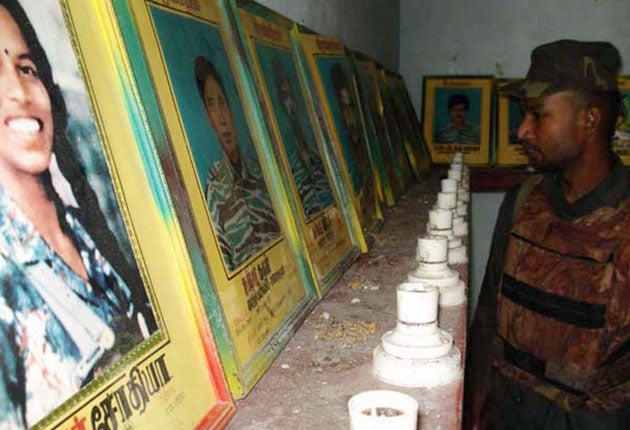Bombs close last hospital in Sri Lanka's war zone
Hundreds of thousands left without care as brutal civil war continues to rage

Hundreds of thousands of civilians caught up in Sri Lanka's civil war have been left without a medical clinic after the last working hospital in the war zone was evacuated yesterday when it came under fire from artillery shells and cluster bombs.
Scores of civilians are continuing to be killed and wounded as both sides reject calls for a ceasefire that would allow the evacuation of non-combatants from the war zone. Officials said at least 52 civilians were killed in a 24-hour period in just one part of the area.
The crucial hospital, located in the Tamil town of Puthukkudiyiruppu, was emptied of patients and staff after coming under repeated fire. Yesterday morning, cluster munitions fell nearby and a decision was taken to flee.
"There was sustained artillery fire at the hospital during the night and in the morning and it was decided to evacuate it. It's now empty. It was the last medical facility," said Gordon Weiss, a UN spokesman in Sri Lanka's capital, Colombo. "A few hours later our staff, who were nearby, also pulled out, along with their family members. We are only getting snapshots but they are consistent and they tell of the toll on civilians."
Consisting of a payload of small bombs that spread over a wide area, cluster bombs are notorious for their impact on civilians and are particularly difficult to find and remove after a conflict has ended. In May 2008, 107 nations adopted the international Convention on Cluster Munitions, but Sri Lanka was not among them.
While the hospital had been struck several times by artillery shells fired from positions occupied by both government troops and rebel fighters, Mr Weiss suggested that the cluster munitions – believed to have been used for the first time since a ceasefire between the two sides broke down two years ago – had been fired by the rebels. "The government has assured us that they do not have these munitions and we have accepted that," he added.
Meanwhile, Sarasi Wijeratne, a spokeswoman for the International Committee of the Red Cross, confirmed it had evacuated the hospital. It is understood that the majority of the patients were taken further north, though their destination was unclear.
The unrelenting conflict between government forces and the Liberation Tigers of Tamil Eelam (LTTE) came as the US and UK called for both sides to enact a ceasefire. In a statement, the British Foreign Secretary, David Miliband, and the US Secretary of State, Hillary Clinton, called on both sides "to allow civilians and wounded to leave the conflict area and to grant access for humanitarian agencies".
If anything, the fighting seems set to intensify as the government seeks to crush the separatist LTTE, which has have been using guerrilla tactics and suicide bombers to fight for an independent Tamil homeland for the past 30 years. At a speech to celebrate Sri Lanka's 61st Independence Day yesterday, President Mahinda Rajapaksa said soldiers had "defeated the cowardly forces of terror that had wrapped our entire nation in fear".
Mr Weiss said there was evidence that the LTTE, forced into an ever-diminishing area of jungle, had been preventing civilians from crossing the front lines and escaping the conflict. He said LTTE fighters had also tried to commandeer two UN vehicles, but desisted once the staff argued with them.
Aid groups say that about 250,000 Tamil civilians are trapped in a small sliver of land measuring just 30 square miles, where the last of the LTTE fighters are holed up. Even though the government is confident of destroying the rebels, many rebels believe the remnants of the force will return to the jungle and restart their previous guerrilla war unless there is a political settlement. The government has said it has a plan for a political settlement, but that progress on that issue can only be made once the LTTE has been defeated.
Spoils of war: Rebel leader's luxury bunker found
Uncertainty hangs over the fate of the LTTE's leader, Velupillai Prabhakaran. Reports say the rebel commander may have tried to flee the country but there has been no evidence to confirm that. This week, however, government troops revealed what they said was his underground bunker, a "luxury" hideout complete with air-conditioning, sound-proof generators, a four-poster bed and CCTV.
The bunker is located in the coastal town of Mullaitivu, which the government secured last month. The two-storey complex had an oxygen machine, a supply of insulin – Prabhakaran is said to be diabetic – and was covered with three feet of concrete.
"The underground bunker was fully air-conditioned and consisted of four furnished apartments and tiled floor," the Defence Ministry said. The government said troops also found a "colossal torture chamber-cum-open prison" near Visuamadu, a community they captured this week. Reports said the five-acre site had a 10ft-high barbed wire fence around it and contained small concrete cells. The soldiers also found a metal cage with a pair of handcuffs welded to the floor. They also found a "heating chamber" that may have been used for "severe punishment". There is no way to independently verify these reports as journalists are barred from the combat zone.
Join our commenting forum
Join thought-provoking conversations, follow other Independent readers and see their replies
Comments